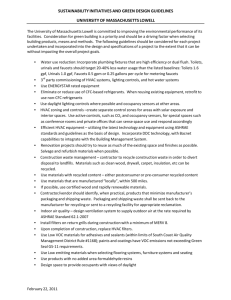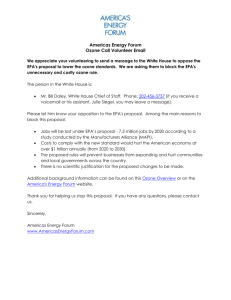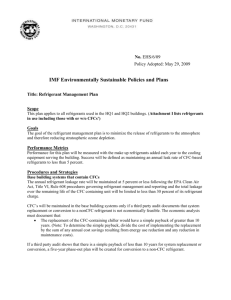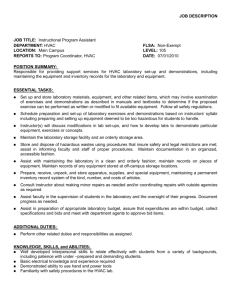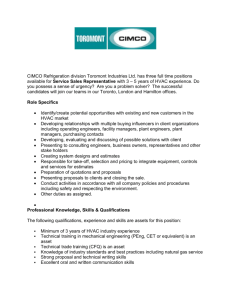EPA Section 608 Study Guide - HVACR-Knowledge
advertisement
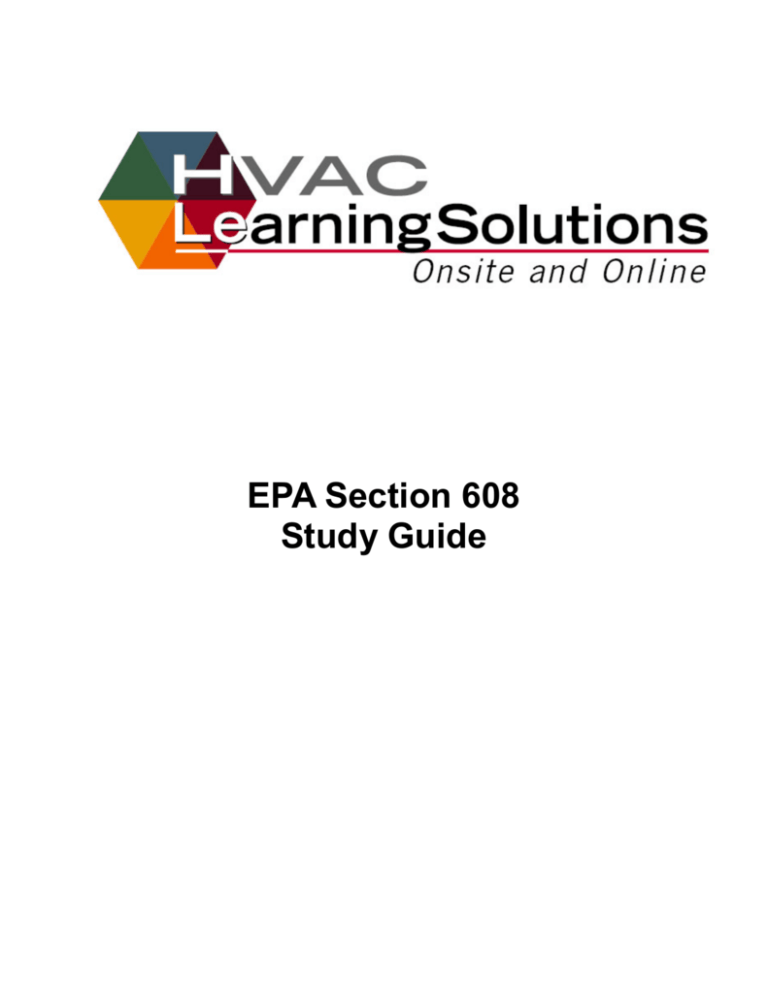
EPA Section 608 Study Guide HVAC Learning Solutions Table of Contents • Introduction ....................................................................................... 3 Who is the EPA? ............................................................................................. 3 What are the requirements for HVAC contractors? .......................................... 3 • Basic EPA Certification ..................................................................... 4 Introduction ..................................................................................................... 4 History............................................................................................................. 4 Environmental Protection Agency (EPA)......................................................... 4 Our Role.......................................................................................................... 4 The Ozone Layer ............................................................................................. 4 Ozone Depletion .................................................................................................. 5 Different compounds............................................................................................ 5 Effects .................................................................................................................. 5 What is being Done? ............................................................................................ 5 The Clean Air Act ................................................................................................ 5 New Refrigerants/Same Rules ............................................................................. 5 Compliance .......................................................................................................... 6 Conclusion ........................................................................................................... 6 • EPA Certification, Type I & II .......................................................... 7 Definitions....................................................................................................... 7 Leak Symptoms/Repairs .................................................................................. 7 Safety .............................................................................................................. 7 Must Do’s/ Don’t’s .......................................................................................... 8 Summary ......................................................................................................... 8 EPA Leak Regulations..................................................................................... 8 Refrigeration Systems...................................................................................... 9 • EPA Certification, Type III ............................................................. 10 Introduction ................................................................................................... 10 Leak Checking............................................................................................... 10 Purge Units.................................................................................................... 10 Charging........................................................................................................ 10 Evacuation Requirements .............................................................................. 11 ii 2006 HVAC Learning Solutions © HVAC Learning Solutions CHAPTER 1 Introduction Who is the EPA? The Environmental Protection Agency (EPA) is an agency of the United States government. This agency regulates the sale and use of all refrigerants What are the requirements for HVAC contractors? Technicians servicing products must be certified under the proper category: TYPE I- Small appliances, Systems containing under 5 pounds of refrigerant TYPE II- Most residential split systems (containing less than 50 pounds of refrigerant) TYPE III- Any system containing more than 50 pounds of refrigerant (ex: chillers) © 2006 HVAC Learning Solutions 3 HVAC Learning Solutions CHAPTER 2 Basic EPA Certification Introduction In 1974, research theorized that chlorine compounds might be destroying the ozone layer above the earth. These compounds are present in many of the refrigerants used today and represent a global problem. History Modern refrigeration, much as it is today, began with the introduction of chloro-flourocarbons (CFC’s) in the early 1930’s. Environmental Protection Agency (EPA) In 1978, the EPA banned the use of CFC’s as aerosol propellants (except for some medicines). At one time over 50% of the total consumption of CFC’s in this country were for aerosols. Our Role To be informed To be skilled To be certified To be in compliance The Ozone Layer Ozone consists of 3 oxygen atoms in each molecule as opposed to 2 in air-borne oxygen It acts as a shield against UV radiation At ground level it is considered a pollutant and harmful It forms at ground level when UV rays act on smog © 2006 HVAC Learning Solutions 4 HVAC Learning Solutions Ozone Depletion There are many theories about the causes of ozone depletion, but it is known that certain chemicals do contribute to damage to the ozone layer The chlorine atoms from CFC’s are among the worst offenders of all man made chemicals Chlorine atoms combine with the ozone molecules to break it down to oxygen CFC’s do not dissolve in water and do not break down even years later Each chlorine atom can destroy up to 100,000 ozone molecules Different compounds CFC’s are considered to be the most harmful to the ozone layer (R-12 for example) HCFC’s are less harmful but still represent a threat (R-22) HFC’s do not pose a threat to the ozone layer but do have a global warming potential (R134A, R410A) Effects Depletion of the ozone layer has resulted in an increase in UV radiation and, damage to marine life crop damage increased skin cancers increased cataracts global warning What is being Done? Capturing and ultimately eliminating CFC’s and HCFC’s Using cleaner burning fuels Enforcing strict requirements on incinerators Enforcement of the clean air act The Clean Air Act Prohibits venting of refrigerants Requires the recovery of refrigerants before appliance disposal Calls for the phase out of CFC’s and HCFC’s Levies fines for non-compliance New Refrigerants/Same Rules CFC’s (Class I), HCFC’s (CLASS II) and HFC’s all need to be recovered Recovery equipment must be certified by the EPA Are illegal to knowingly release into the atmosphere (except de minimus during service) © 2006 HVAC Learning Solutions 5 HVAC Learning Solutions Compliance Violations may lead to fines, loss of certification, and possible court proceedings Awards of up to 10,000.00 may be paid to informants Fines up to 27,500 per day for violations Conclusion While some natural occurrences contribute to ozone depletion, CFC’s have a much greater potential for damage. Ongoing research has measured CFC’s in air samples from the stratosphere © 2006 HVAC Learning Solutions 6 HVAC Learning Solutions CHAPTER 3 EPA Certification, Type I & II Definitions Small Appliances are products containing less than 5 pounds of refrigerant and charged and hermetically sealed by the factory Technicians certified as “Type I” or as “Universal” may service, repair or recover the refrigerant contained in a small appliance MVAC is not included in this category Leak Symptoms/Repairs While not mandatory, leaks should be repaired when found Before recovery you must know the type of refrigerant in the system to avoid cross contamination Recovery equipment must be able to recovery 90% of the charge and 4” vacuum with a working compressor (80% with non working compressor) Passive recovery captures refrigerant in a non-pressurized container The compressor must be heated and struck to release trapped refrigerant in the oil If the compressor doesn’t run, the system needs to have access valves on the high as well as low side Nitrogen tanks must have a regulator Safety Refrigerants may form phosgene gas when heated Equipment must have low loss fittings or hand valves Only freon type refrigerants should be recovered Cylinders should not be stored above 125*F © 2006 HVAC Learning Solutions 7 HVAC Learning Solutions Must Do’s/ Don’ts Systems with 134a or 410a must have a dedicated set of gauges and recovery cylinders Don’t mix refrigerants or oils Do use approved recovery cylinders they are color coded with a band on the top Do have them tested every 5 years Do not exceed 80% of the w.c. Summary Traces of oil may indicate a leak It is ok to use nitrogen for pressure checking type I or II products after they have been recovered A small amount of R-22 may be added to nitrogen for leak checking and does not need to be recovered EPA Leak Regulations Comfort equipment containing more than 50# of refrigerant must be repaired when the leak exceeds 15% per year Commercial refrigeration leak rate is 35% for cold storage equipment in restaurants ice plants and supermarkets Refrigerant monitors are mandatory in equipment rooms using all types of refrigerants © 2006 HVAC Learning Solutions 8 HVAC Learning Solutions Refrigeration Systems Moisture is removed by a filter drier on the liquid line (high Pressure) Large amounts of moisture may need to have nitrogen added to reduce freezing during vacuuming Deep vacuums are measured in microns Evacuation removes non-condensables, which raise discharge pressure Too large a vacuum pump may cause freezing of trapped water Recovered refrigerant may contain oil, moisture and acids (from a compressor burnout Recovering refrigerant in the liquid phase will speed up the recovery process, but will result in the loss of oil in the system Vapor recovery is slower but does it without pulling oil from the system Recovery cylinders should be evacuated before initial use © 2006 HVAC Learning Solutions 9 HVAC Learning Solutions CHAPTER 4 EPA Certification, Type III Introduction Systems containing more than 50 Pounds of refrigerant Generally use semi-hermetic compressors May be high or low- pressure systems May include absorption chillers Leak Checking Open drive compressors should be checked at the drive shaft seal area first Low- pressure systems often have air leaks at gaskets and fittings High head pressure is a good indicator of a leak Never pressure test low pressure systems with more than 10 psig of pressure Hydrostatic test kits will determine if a tube leaks Leak detectors can be inserted into a drain valve to test for freon leaks in the water box After recovering all the liquid freon possible, the vapor must be recovered completely, nearly 100# may still remain Purge Units Remove non-condensables Can be manual or motorized Excessive running of a motorized purge system indicates a leak High efficiency units discharge very little refrigerant with each purge Charging Charging with liquid into a system under a vacuum will cause the water to freeze Water must be circulated through the chiller when evacuating to prevent freezing © 2006 HVAC Learning Solutions 10 HVAC Learning Solutions Heating a refrigerant bottle may speed vapor charging Evacuation Requirements Type III equipment must be evacuated to 25” hg After evacuation you must wait several minutes to see if the pressure rises (refrigerant could be trapped in the oil) Remember, low pressure systems may operate in a vacuum At 30 to 35 degrees the pressure could be 10 to 12” hg. © 2006 HVAC Learning Solutions 11
